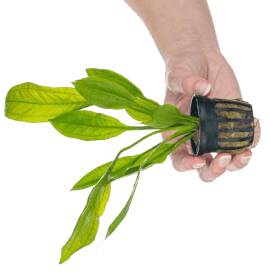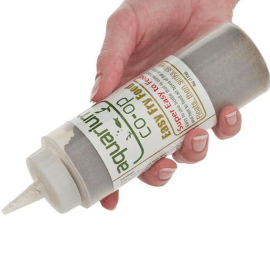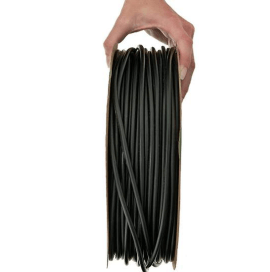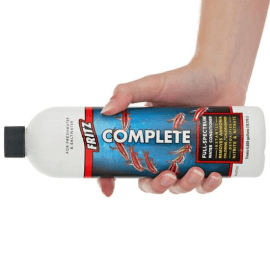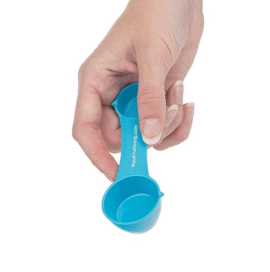Water Dechlorinator: How It Works and How Much to Use in Aquariums
Many fishkeepers are unclear about water conditioners for aquariums — how they work, potential risks from overdosing, and the differences amongst the many brands of dechlorinators. Based on the available research and our years of experience using them, let’s talk about the truth behind water conditioners and answer your frequently asked questions.
Do Fish Really Need Water Conditioner?
Maybe. If your drinking water comes from a municipal water supply or other public water system, then most likely it is disinfected with chemicals like chlorine or chloramine to eliminate bacteria, viruses, and other microorganisms that can cause diseases. These chemicals are toxic to aquatic animals and beneficial bacteria and therefore must be removed from the water using a dechlorinator. If you forget to add water conditioner to the tap water, your fish’s gills may become burned, causing them to start gasping or breathing heavily.
If your drinking water comes from a well or other water source that is untreated with chemicals, your aquariums may not need water conditioner. We suggest getting your well water tested to see if it contains any heavy metals because some dechlorinators can help remove them.
Does letting water sit remove chlorine? Yes, chlorine is fairly unstable and will gradually evaporate from water. However, many water treatment plants have begun using chloramine instead of chlorine because it is a more stable disinfectant formed by combining ammonia and chlorine. Chloramine cannot be easily removed from water via evaporation and must be neutralized using dechlorinator. If you are sure your tap water contains chlorine and not chloramine, you can let the water sit for 1-5 days to allow all the chlorine to evaporate. To speed up the evaporation process, aerate the water with an air stone for 12-24 hours or boil the water for 15-20 minutes. Use multi-test strips to measure the water and make sure no chlorine is left.

Air stones connect to an air pump and airline tubing to inject air into the water, agitate the water surface, and speed up gas exchange.
What Does Dechlorinator Do?
The main purpose of water conditioners is to break down chlorine and chloramine and make water safe for fish to inhabit. Almost all dechlorinators contain sodium thiosulfate, which reacts to chlorine and chloramine to form harmless byproducts. Sodium thiosulfate looks like rock salt or white powder, and it is often dissolved in water to create liquid dechlorinators. Some water conditioners contain pH buffers, aloe vera to help heal the fish’s slime coats, or extra additives.
Does dechlorinator remove ammonia? Some of them do, as stated on their packaging. The main reason for this is because when dechlorinators are used to treat chloramine, they only react to the chlorine part of chloramine and not the ammonia part. The remaining ammonia ions left in the water are toxic to fish, so some dechlorinators — such as Aquarium Co-Op Easy Dechlorinator, Fritz Complete Water Conditioner, Seachem Prime, and Kordon AmQuel — contain extra chemicals that temporarily lock up the ammonia into an inert state (i.e., ammonium) for up to 24 hours. During this time, the ammonium can be consumed and further broken down by beneficial bacteria in your aquarium and filter.

All dechlorinators neutralize chlorine and chloramine, but some like our Easy Dechlorinator contain extra chemicals to treat ammonia, nitrite, and heavy metals.
Will dechlorinator remove bleach? Yes, dechlorinator will react to the chlorine in bleach to neutralize it more quickly. The amount of dechlorinator needed depends on the amount and concentration of bleach used. As a starting point, see the directions for neutralizing Purigen chemical filtration media after it has been soaking in a bleach solution.
Is Dechlorinator Harmful to Fish?
Generally speaking, no. However, there are some rare, one-off cases where it could be potentially dangerous. The reducing agents in dechlorinator use up oxygen when removing chlorine from the water, and this reaction could be hazardous in poorly oxygenated tanks. For instance, goldfish and discus aquariums can require huge 90% water changes. If you are using water with low oxygen content, adding lots of dechlorinator will further deplete the available oxygen, which can potentially suffocate your fish and beneficial bacteria.
Most fishkeepers try to prevent this from happening by increasing surface agitation in their aquariums to improve gas exchange — the process in which carbon dioxide (CO2) exits and fresh oxygen enters the tank water. However, hobbyists with high tech planted aquariums that inject pressurized CO2 often seek to minimize surface agitation. The intent is to decrease gas exchange so that more CO2 stays in the water for the plants to use. Combine this with the fact that plants only consume CO2 during the daytime and then they consume oxygen at night. Therefore, if you do a water change in the early morning right as the lights turn on, the dissolved oxygen in the water will be at its lowest point. Adding low-oxygen water and dechlorinator could be a recipe for disaster for your aquatic animals.
How Much Dechlorinator Should I Use per Gallon?
Every dechlorinator is different, so follow the dosing instructions on the package. As an example, Easy Dechlorinator calls for 1 ml of dechlorinator per 10 gallons of water. What makes these directions a little confusing is that different municipalities use different amounts of chlorine in their water, so how do you know what is the right concentration for your water? Since the dechlorinator manufacturers do not know how much chlorine your town uses, they deliberately make general guidelines that will hopefully cover everyone’s tap water.

Easy Dechlorinator comes with a convenient dosing cap for easily measuring out 1, 5, or 10 ml of dechlorinator (where 1 ml treats 10 gallons of water).
How long does it take for dechlorinator to work? Since it takes about 2-5 minutes for chlorine and chloramine to be neutralized, many companies officially state that you should dose the dechlorinator to the tap water in a separate container before adding the water to the aquarium. That being said, we always add the water conditioner directly to the aquarium and then pour in fresh tap water, and there have never been any problems.
Can you put too much dechlorinator in your fish tank? With Easy Dechlorinator, you can treat extremely high levels of chloramine, nitrite, or other toxic chemicals by dosing up to 5 times the recommended amount within the span of 24 hours. This is a very large range that allows much room for error. Just keep in mind that potent concentrations of dechlorinator will quickly reduce the amount of dissolved oxygen, so it may be best to add an air stone for the next 3-4 hours to increase oxygenation in the water.
It wouldn’t be a bad idea to look up the average chlorine usage for your municipality and run a few experiments at home. Let’s say you find out your town uses 2 ppm (parts per million) of chlorine. If you do a 30% water change on a 100-gallon aquarium and you dose 3 ml of Easy Dechlorinator into 30 gallons of tap water, does the chlorine test register as 0 ppm? Can you get away with less water conditioner, or do you need to dose more pumps to completely eliminate the chlorine? Bottom line: test your water to use the least amount of dechlorinator you can get away and make sure your fish don’t run out of oxygen.

Use a multi-test strip to quickly measure how much chlorine is in your water.
Many people ask for our recommendation on the best water conditioner to use, which is why we came out with our own brand of Easy Dechlorinator. It comes with a super easy dosing cap for treating 10, 50, and 100 gallons of water. For smaller aquariums, just use a pipette to dose 2 drops of dechlorinator per gallon. It's the perfect dechlorinator to use for regular water changes, water top-offs for evaporation, or setting up a new aquarium.
